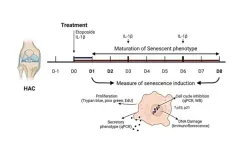(Press-News.org) Philadelphia, September 20, 2023 – Zebrafish have revolutionized research into a wide variety of rare and complex genetic diseases. In early development stages, their transparent bodies allow researchers to more easily study tissues and organs. However, studying organ-level defects in adult zebrafish presents a variety of challenges that prevent researchers from studying them at a microscopic level.
In a new study, researchers from Children’s Hospital of Philadelphia (CHOP) have developed a noninvasive method for conducting magnetic resonance imaging (MRI) in adult zebrafish. Using this technique, the study team examined the effects of certain genetic mutations associated with mitochondrial disease.
The findings were recently published online by the journal Zebrafish.
Zebrafish transition from a single cell to fully formed animal in just one day, with continued larval development over the first week of life. This rapid development and ability to remove their body wall pigment during this early period enables scientists to microscopically image whole organs and perform accurate time-lapse analyses of disease progression. They can also screen drug candidates that may be used to treat various illnesses, since the zebrafish can absorb the drug through their gut, skin, or thin gills. In addition, zebrafish are often used to create models to study diseases because zebrafish share about 70% of genes found in humans.
However, as zebrafish get older, their tissue becomes denser and their organs become more difficult to study through usual microscopic imaging techniques. While MRI has been used to study zebrafish, prior studies have been very limited and did not provide systematic organ-level analyses. This is particularly important for diseases like mitochondrial disease, which often impacts multiple organs by disrupting energy levels in cells throughout the body. No prior study studied adult zebrafish across different times in their adulthood, which prevented researchers from looking into the progression of disease.
“MRI technology is widely used for a variety of clinical and research applications, and as zebrafish become a more preferred model for translational research, we wanted to explore how this technology could improve the research we are doing in these animal models,” said first study author Sonal Sharma, MD, a pediatric neurologist within the Division of Neurology and the Mitochondrial Medicine Frontier Program in the Division of Human Genetics at CHOP. “This work demonstrated that MRI allows us to rapidly and comprehensively study organ-level growth defects in mutant adult zebrafish in a low-cost, minimally invasive, and unbiased manner.”
The researchers developed a new protocol for utilizing MRI in zebrafish research. As a result, they were able to successfully capture high-resolution MRI of eight different organs in adult zebrafish. This allowed the researchers to establish a reference MRI atlas based on images of zebrafish from five to 31 months after fertilization.
Using three different mitochondrial disease mutant models of zebrafish, the researchers were able to discover that significantly increased brain growth occurs in zebrafish with deficiency in the SURF1 gene, which encode mitochondrial complex IV activity and is one of the genes associated with Leigh syndrome. They also noticed heart and spinal cord volumes were smaller in these mutant zebrafish as compared to healthy wild-type controls. These findings reflect some of the clinical observations seen in human patients with SURF1 deficiency, since they may suffer from serious neurological issues as well as cardiomyopathy.
“We plan on exploring the organ-level discoveries we made by using this novel MRI method to screen organ growth in adult zebrafish,” said senior study author Marni Falk, MD, senior author on this study and executive director of the Mitochondrial Medicine Frontier Program at CHOP. “We are also working to develop additional biochemical imaging methods to further refine our understanding of the biochemical changes that occur in specific organs of living animals with primary mitochondrial disease.”
This study was supported by the Children’s Hospital of Philadelphia Mitochondrial Medicine Fellowship Program and the National Institutes of Health grant R35-GM134863.
Sharma et al, “Novel Development of Magnetic Resonance Imaging to Quantify the Structural Anatomic Growth of Diverse Organs in Adult and Mutant Zebrafish.” Zebrafish. Online August 21, 2023. DOI: 10.1089/zeb.2023.0018.
About Children’s Hospital of Philadelphia: A non-profit, charitable organization, Children’s Hospital of Philadelphia was founded in 1855 as the nation’s first pediatric hospital. Through its long-standing commitment to providing exceptional patient care, training new generations of pediatric healthcare professionals, and pioneering major research initiatives, the 595-bed hospital has fostered many discoveries that have benefited children worldwide. Its pediatric research program is among the largest in the country. The institution has a well-established history of providing advanced pediatric care close to home through its CHOP Care Network, which includes more than 50 primary care practices, specialty care and surgical centers, urgent care centers, and community hospital alliances throughout Pennsylvania and New Jersey, as well as an inpatient hospital with a dedicated pediatric emergency department in King of Prussia. In addition, its unique family-centered care and public service programs have brought Children’s Hospital of Philadelphia recognition as a leading advocate for children and adolescents. For more information, visit https://www.chop.edu.
END
CHOP researchers develop novel method using MRI to study diseases modeled in zebrafish
This initial study found evidence linking changes in organ development with symptoms seen in certain human mitochondrial diseases
2023-09-20
ELSE PRESS RELEASES FROM THIS DATE:
15 top journalists earn aging-focused reporting fellowships
2023-09-20
The Gerontological Society of America (GSA) and the Journalists Network on Generations are welcoming 15 distinguished reporters for the next cohort of the Journalists in Aging Fellows Program, now in its 14th year.
They represent a wide range of general audience, ethnic, and community media outlets, including local and national publications. This year’s group brings the program’s total number of participating reporters to 232. The new fellows were chosen — by a panel of gerontological and editorial professionals — based on their proposals for ...
A brighter brain future for all: AAN sets new vision for brain health by 2050
2023-09-20
MINNEAPOLIS – Do you want to improve your brain health? Neurologists, the experts in brain health, have a plan. The American Academy of Neurology (AAN), the world’s largest association of neurologists and neuroscience professionals with over 40,000 members, is sharing its vision to improve the nation’s brain health by 2050. The new vision is part of a new AAN position statement on brain health, published online September 20, 2023, in Neurology®, the medical journal of the American Academy of Neurology.
The AAN’s vision for national brain health by 2050 includes:
Brain health research that leads to scientific breakthroughs
Preventive neurology as a thriving ...
St. Jude refines definition and hones treatment of hyperdiploid leukemia
2023-09-20
(Memphis, Tenn.— Sept. 20, 2023) Hyperdiploidy is a genetic condition observed in cancer cells, where the cells contain more chromosomes than usual. The condition is particularly prevalent in childhood B-cell acute lymphoblastic leukemia (B-ALL), the most common form of pediatric cancer. To bring clarity to the field, researchers at St. Jude Children’s Research Hospital worked to better define this type of ALL in the context of modern therapy to more accurately predict patient outcomes and guide treatment decisions. The findings were published today in the Journal of Clinical ...
USC develops new preclinical system to better turn lab discoveries into effective treatments
2023-09-20
It is an all-too-common fact that potential drugs can look extremely promising in preclinical laboratory testing but fail when it comes to effectively treating humans. To better translate promising lab findings into effective new treatments, a team of researchers from the Keck School of Medicine of USC, supported by the National Institutes of Health, has developed, and tested, an innovative new system for conducting preclinical research on six potential new stroke treatments, identifying the strongest candidate for further study.
“We now have a feasible preclinical research system ...
Health organizations host Forum on Innovation and the Health Care Workforce
2023-09-20
The American College of Cardiology (ACC), NCD Alliance and World Heart Federation (WHF), with support from Viatris, brought together leaders in global health and technology for a “Enhancing the Health Workforce Through Innovation,” forum yesterday in New York. The event was held in advance of the 78th session of the U.N. General Assembly discussion on the need for universal health coverage to improve global access to care and reduce the out-of-pocket burden of rising health care costs.
“ACC has been committed to improving health care for all ...
DPP4 inhibitors for target therapy resistance in renal cell carcinoma
2023-09-20
“[...] we demonstrated that DPP4 inhibition increased sunitinib efficacy in DPP4-high RCC spheroids and DPP4 was upregulated in sunitinib-resistant RCC cells.”
BUFFALO, NY- September 20, 2023 – A new editorial paper was published in Oncotarget's Volume 14 on September 15, 2023, entitled, “Potential repurposing of DPP4 inhibitors for target therapy resistance in renal cell carcinoma.”
In their new editorial, researchers Kuniko Horie and Satoshi Inoue from Saitama Medical University and Tokyo Metropolitan Institute for Geriatrics and Gerontology discuss renal cell carcinoma (RCC) — a major ...
DNA damage-induced senescence model in osteoarthritic chondrocytes
2023-09-20
“This etoposide-induced senescence model may help investigate the initiation of cellular senescence in chondrocytes [...]”
BUFFALO, NY- September 20, 2023 – A new research paper was published in Aging (listed by MEDLINE/PubMed as "Aging (Albany NY)" and "Aging-US" by Web of Science) Volume 15, Issue 17, entitled, “Development of a DNA damage-induced senescence model in osteoarthritic chondrocytes.”
Senescent cells (SnCs) have been described to accumulate in osteoarthritis (OA) joint tissues in response to injury, thereby participating in OA development and progression. However, clinical therapeutic approaches targeting SnCs using senolysis, ...
Socially vulnerable populations are disproportionately exposed to wildfires in the West, study finds
2023-09-20
CORVALLIS, Ore. – People experiencing a high degree of social vulnerability are also more exposed to wildfires in Oregon and Washington as wildfire risk increases, a new study shows.
Social vulnerability is a characteristic of a person or community, such as age, race or ethnicity or socioeconomic status, that affects their susceptibility to incur harm from a hazard.
From 2011 through 2021, the number of people with high social vulnerability who were exposed to wildfire in Oregon, Washington and California more than tripled compared to the previous decade. This compounding ...
Computational model helps with diabetes drug design
2023-09-20
CAMBRIDGE, MA -- For diabetes patients who must give themselves frequent insulin injections, the risk of low blood sugar can be life-threatening. A potential solution is a type of engineered insulin that circulates in the body and springs into action only when needed. Researchers working on this type of “glucose-responsive insulin” (GRI) hope that it could be injected less often and help the body maintain normal blood sugar levels for longer periods of time.
To help in the efforts to develop this kind of insulin, MIT engineers have created a computational model that ...
Lungs play a critical role in fetal blood development, new study from Boston Medical Center and Boston University’s Center for regenerative medicine finds
2023-09-20
BOSTON – A newly-released study by Boston Medical Center (BMC) and Boston University’s Center for Regenerative Medicine (CReM) found that the fetal lung is a potential source of hemogenic endothelial cells (HECs) that have the capacity to make blood. The findings broaden the understanding of where and how blood forms, which has the potential to enhance the treatment of blood-related diseases such as leukemia and lymphoma. Previously, no lung HECs had ever been detected.
“Our findings show that hemogenic endothelium, which was previously thought to be restricted to ...
LAST 30 PRESS RELEASES:
Sleeping in on weekends may help boost teens’ mental health
Study: Teens use cellphones for an hour a day at school
After more than two years of war, Palestinian children are hungry, denied education and “like the living dead”
The untold story of life with Prader-Willi syndrome - according to the siblings who live it
How the parasite that ‘gave up sex’ found more hosts – and why its victory won’t last
When is it time to jump? The boiling frog problem of AI use in physics education
Twitter data reveals partisan divide in understanding why pollen season's getting worse
AI is quick but risky for updating old software
Revolutionizing biosecurity: new multi-omics framework to transform invasive species management
From ancient herb to modern medicine: new review unveils the multi-targeted healing potential of Borago officinalis
Building a global scientific community: Biological Diversity Journal announces dual recruitment of Editorial Board and Youth Editorial Board members
Microbes that break down antibiotics help protect ecosystems under drug pollution
Smart biochar that remembers pollutants offers a new way to clean water and recycle biomass
Rice genes matter more than domestication in shaping plant microbiomes
Ticking time bomb: Some farmers report as many as 70 tick encounters over a 6-month period
Turning garden and crop waste into plastics
Scientists discover ‘platypus galaxies’ in the early universe
Seeing thyroid cancer in a new light: when AI meets label-free imaging in the operating room
Neutrophil-to-lymphocyte ratio may aid risk stratification in depressive disorder
2026 Seismological Society of America Annual Meeting
AI-powered ECG analysis offers promising path for early detection of chronic obstructive pulmonary disease, says Mount Sinai researchers
GIMM uncovers flaws in lab-grown heart cells and paves the way for improved treatments
Cracking the evolutionary code of sleep
Medications could help the aging brain cope with surgery, memory impairment
Back pain linked to worse sleep years later in men over 65, according to study
CDC urges ‘shared decision-making’ on some childhood vaccines; many unclear about what that means
New research finds that an ‘equal treatment’ approach to economic opportunity advertising can backfire
Researchers create shape-shifting, self-navigating microparticles
Science army mobilizes to map US soil microbiome
Researchers develop new tools to turn grain crops into biosensors
[Press-News.org] CHOP researchers develop novel method using MRI to study diseases modeled in zebrafishThis initial study found evidence linking changes in organ development with symptoms seen in certain human mitochondrial diseases



